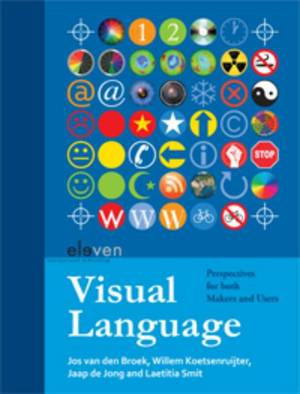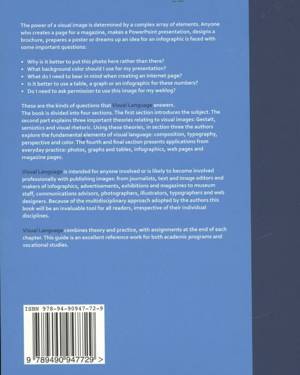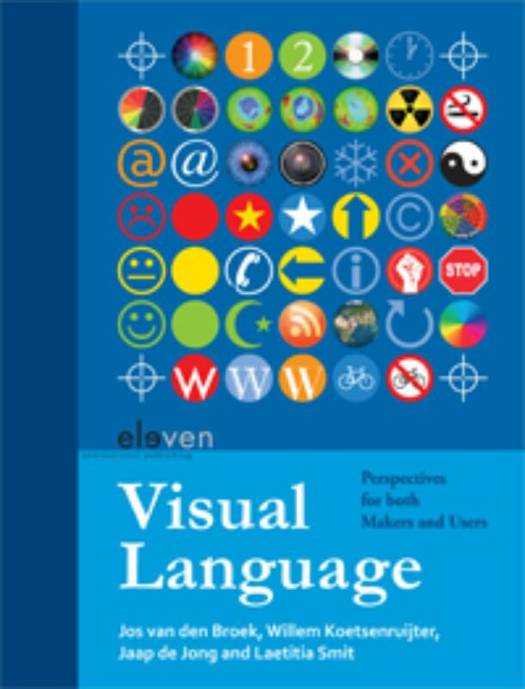
Bedankt voor het vertrouwen het afgelopen jaar! Om jou te bedanken bieden we GRATIS verzending (in België) aan op alles gedurende de hele maand januari.
- Afhalen na 1 uur in een winkel met voorraad
- In januari gratis thuislevering in België
- Ruim aanbod met 7 miljoen producten
Bedankt voor het vertrouwen het afgelopen jaar! Om jou te bedanken bieden we GRATIS verzending (in België) aan op alles gedurende de hele maand januari.
- Afhalen na 1 uur in een winkel met voorraad
- In januari gratis thuislevering in België
- Ruim aanbod met 7 miljoen producten
Zoeken


Visual language
perspectives for both makers and users
Jos van den Broek, Willem Koetsenruijter, Jaap de Jong, Laetitia Smit
Paperback | Engels
€ 67,95
+ 135 punten
Omschrijving
The power of a visual image is determined by a complex array of elements. Anyone who creates a page for a magazine, makes a PowerPoint presentation, designs a brochure, prepares a poster or dreams up an idea for an infographic is faced with some important questions:
* Why is it better to put this photo here rather than there?
* What background color should I use for my presentation?
* What do I need to bear in mind when creating an internet page?
* Is it better to use a table, a graph or an infographic for these numbers?
* Do I need to ask permission to use this image for my weblog?
These are the kinds of questions that Visual Language answers.
The book is divided into four sections. The fi rst section introduces the subject. The second part explains three important theories relating to visual images: Gestalt, semiotics and visual rhetoric. Using these theories, in section three the authors explore the fundamental elements of visual language: composition, typography, perspective and color. The fourth and fi nal section presents applications from everyday practice: photos, graphs and tables, infographics, web pages and magazine pages.
Visual Language is intended for anyone involved or is likely to become involved professionally with publishing images: from journalists, text and image editors and makers of infographics, advertisements, exhibitions and magazines to museum staff , communications advisors, photographers, illustrators, typographers and web designers. Because of the multidisciplinary approach adopted by the authors this book will be an invaluable tool for all readers, irrespective of their individual disciplines.
Visual Language combines theory and practice, with assignments at the end of each chapter. This guide is an excellent reference work for both academic programs and vocational studies.
* Why is it better to put this photo here rather than there?
* What background color should I use for my presentation?
* What do I need to bear in mind when creating an internet page?
* Is it better to use a table, a graph or an infographic for these numbers?
* Do I need to ask permission to use this image for my weblog?
These are the kinds of questions that Visual Language answers.
The book is divided into four sections. The fi rst section introduces the subject. The second part explains three important theories relating to visual images: Gestalt, semiotics and visual rhetoric. Using these theories, in section three the authors explore the fundamental elements of visual language: composition, typography, perspective and color. The fourth and fi nal section presents applications from everyday practice: photos, graphs and tables, infographics, web pages and magazine pages.
Visual Language is intended for anyone involved or is likely to become involved professionally with publishing images: from journalists, text and image editors and makers of infographics, advertisements, exhibitions and magazines to museum staff , communications advisors, photographers, illustrators, typographers and web designers. Because of the multidisciplinary approach adopted by the authors this book will be an invaluable tool for all readers, irrespective of their individual disciplines.
Visual Language combines theory and practice, with assignments at the end of each chapter. This guide is an excellent reference work for both academic programs and vocational studies.
Specificaties
Betrokkenen
- Auteur(s):
- Uitgeverij:
Inhoud
- Aantal bladzijden:
- 304
- Taal:
- Engels
Eigenschappen
- Productcode (EAN):
- 9789490947729
- Verschijningsdatum:
- 1/08/2012
- Uitvoering:
- Paperback
- Afmetingen:
- 190 mm x 240 mm
- Gewicht:
- 655 g

Alleen bij Standaard Boekhandel
+ 135 punten op je klantenkaart van Standaard Boekhandel
Beoordelingen
We publiceren alleen reviews die voldoen aan de voorwaarden voor reviews. Bekijk onze voorwaarden voor reviews.










